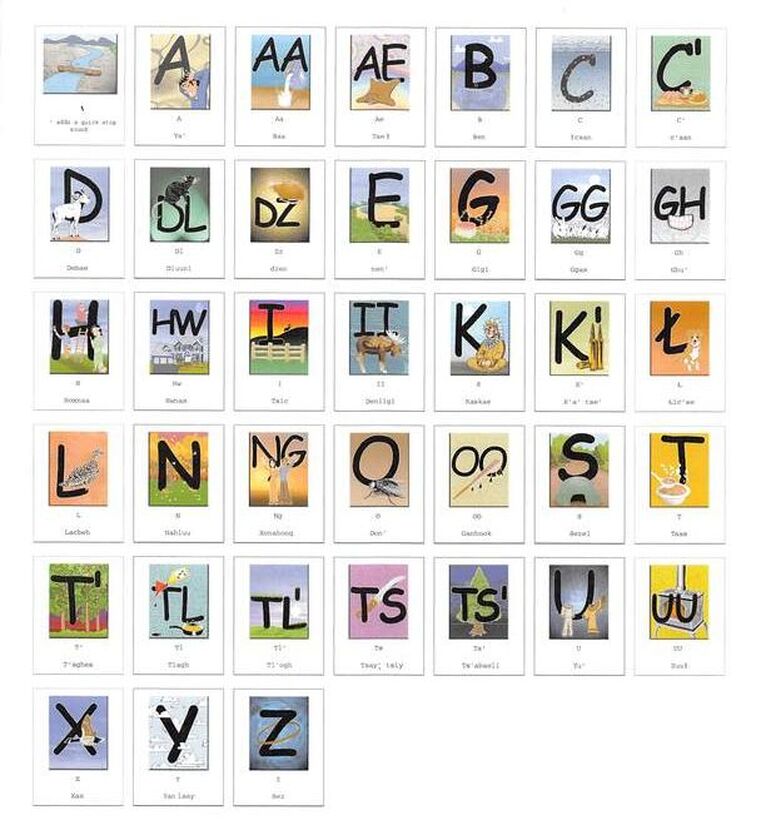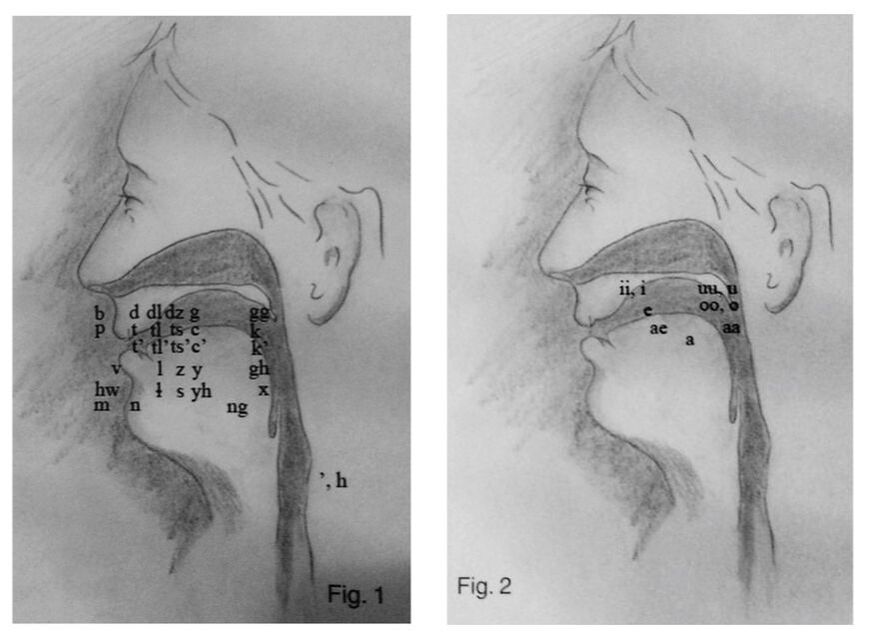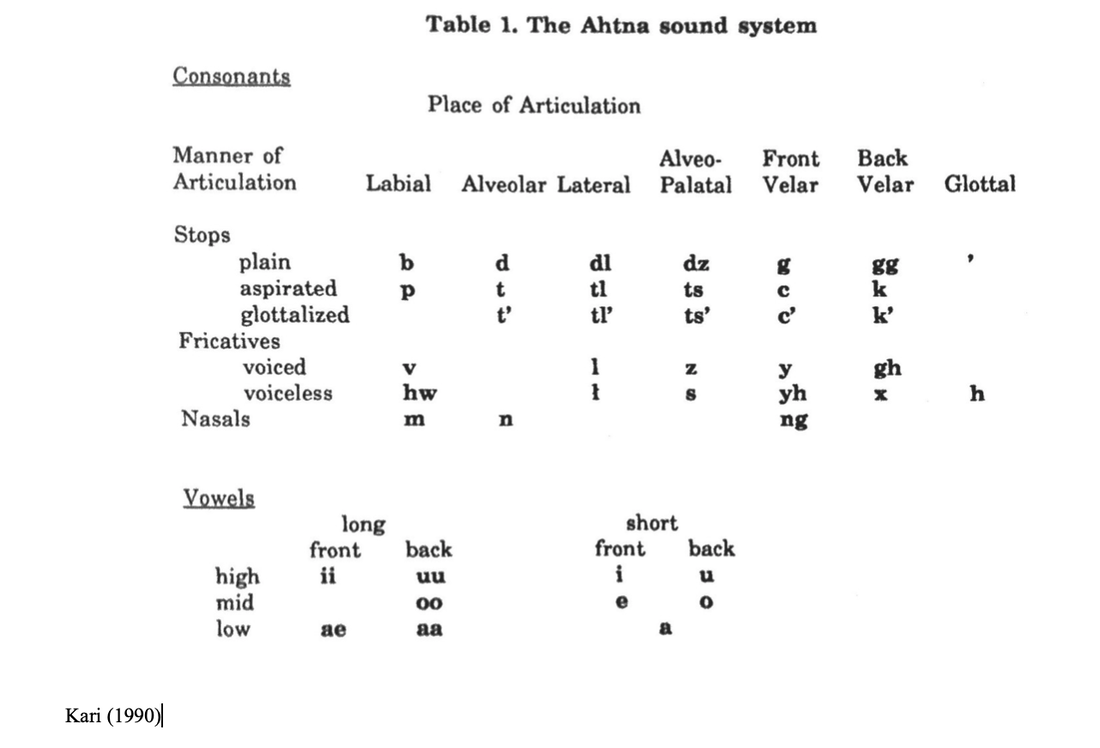Ahtna Alphabet
Chart created by Chickaloon Village, 2004, Artwork created by artist and Tribal Citizen, Dimi Macheras.
Ahtna Athabaskan has 38 Ahtna letters in the alphabet.
I am going to sort the letters out into three groups as Professor Siri Tuttle refers to from her book, Ahtna Athabaskan Grammar Reference, Upper Ahtna Edition, pg. 2-3. She groups the letters into three groups to understand how the letters relate and the differences as compared to the English language.
b, d, g: say bad, dog, and geese
t, c: say toe and case
s, h: say so and hoe
l, z, and y: say low, zoo and you
m, n, and ng: say mow, no, and song
The second group are letter that are found in English but are read differently in Ahtna. There are 10 vowels in Ahtna and they represent the short and long sounds; a, aa, o, oo, u, uu, i, ii, e, ae.
a, aa: say u in bun, and a in father
o, oo: say o in no and oa in road
u, uu: say oo in loot, and u in rule
i, ii: say i in bit, and ee in beet
e, ae: say e in bet, and a in and
Third group is of consonants are sounds that only occur in Ahtna not in English.
': This is sound in the middle of English like unh unh. To make this sound you close off the air from your lungs at the throat.
gg, k: think g in goose, k in mark, and let your tongue touch the back roof of your mouth. Dr. Kari calls them "back velars."
gh, x: think of gh in Agh!, and the way people say the name of the composer Bach as if they had a fishbone in their throat.
Dr. Kari call these "uvular fricatives."
dl, tl: think of puddle and Atlas. Dr. Kari calls these "lateral affricates."
dz, ts: think of Ed's or edge for dz, and cats or catch for ts. Dr. Kari calls these, "affricates."
ł: are voiceless l-like sound that does not occur in English, but it could be kind of heard in the word athlete.
The next consonants are what Dr. Kari would call "stops and affricates." These are words written with an apostrophe also called ejectives.
t': say 'it is', very emphatically, over and over, until it start to sound like one word.
tl': say, "it'll eat to get to itl'eat.
ts': say "it's over' to get it its'over.
k': say 'turn the cake off.' You might get to cak'off.
I am going to sort the letters out into three groups as Professor Siri Tuttle refers to from her book, Ahtna Athabaskan Grammar Reference, Upper Ahtna Edition, pg. 2-3. She groups the letters into three groups to understand how the letters relate and the differences as compared to the English language.
- Sounds that are similar to English.
- Sounds used in both English and Ahtna, but are pronounced differently: vowels.
- Sounds that are not used in English only in the Ahtna language.
b, d, g: say bad, dog, and geese
t, c: say toe and case
s, h: say so and hoe
l, z, and y: say low, zoo and you
m, n, and ng: say mow, no, and song
The second group are letter that are found in English but are read differently in Ahtna. There are 10 vowels in Ahtna and they represent the short and long sounds; a, aa, o, oo, u, uu, i, ii, e, ae.
a, aa: say u in bun, and a in father
o, oo: say o in no and oa in road
u, uu: say oo in loot, and u in rule
i, ii: say i in bit, and ee in beet
e, ae: say e in bet, and a in and
Third group is of consonants are sounds that only occur in Ahtna not in English.
': This is sound in the middle of English like unh unh. To make this sound you close off the air from your lungs at the throat.
gg, k: think g in goose, k in mark, and let your tongue touch the back roof of your mouth. Dr. Kari calls them "back velars."
gh, x: think of gh in Agh!, and the way people say the name of the composer Bach as if they had a fishbone in their throat.
Dr. Kari call these "uvular fricatives."
dl, tl: think of puddle and Atlas. Dr. Kari calls these "lateral affricates."
dz, ts: think of Ed's or edge for dz, and cats or catch for ts. Dr. Kari calls these, "affricates."
ł: are voiceless l-like sound that does not occur in English, but it could be kind of heard in the word athlete.
The next consonants are what Dr. Kari would call "stops and affricates." These are words written with an apostrophe also called ejectives.
t': say 'it is', very emphatically, over and over, until it start to sound like one word.
tl': say, "it'll eat to get to itl'eat.
ts': say "it's over' to get it its'over.
k': say 'turn the cake off.' You might get to cak'off.
Ahtna Sound System
In figure 1 shows where the consonant sounds are made in the mouth beginning with front of the mouth to the back to the throat. Figure 2 demonstrates where the sound of the vowels are made in the mouth. Both figures were illustrated by Dr. Siri Tuttle.
If we follow when we make the sounds from left to right from the top down: b, d, dl, dz, g, gg, '.... we can feel the sounds being made in the same places as on the figures 1 and 2 and table 1, below.
If we follow when we make the sounds from left to right from the top down: b, d, dl, dz, g, gg, '.... we can feel the sounds being made in the same places as on the figures 1 and 2 and table 1, below.
Here in Table 1 is a different way to visualize how the sounds are made, from Jim Kari's 1990, Ahtna Athabaskan Dictionary, is a table of the Ahtna Sound System with the correct terms for manner of articulation. Here we can see which letters are stops, fricative and nasals sounds with the vowels long and short sounds and where the letters are made in front or back of the mouth.
Here are three YouTube videos on Ahtna Sound System for the vowels, stops, nasals and fricatives.
|
|
|
|



